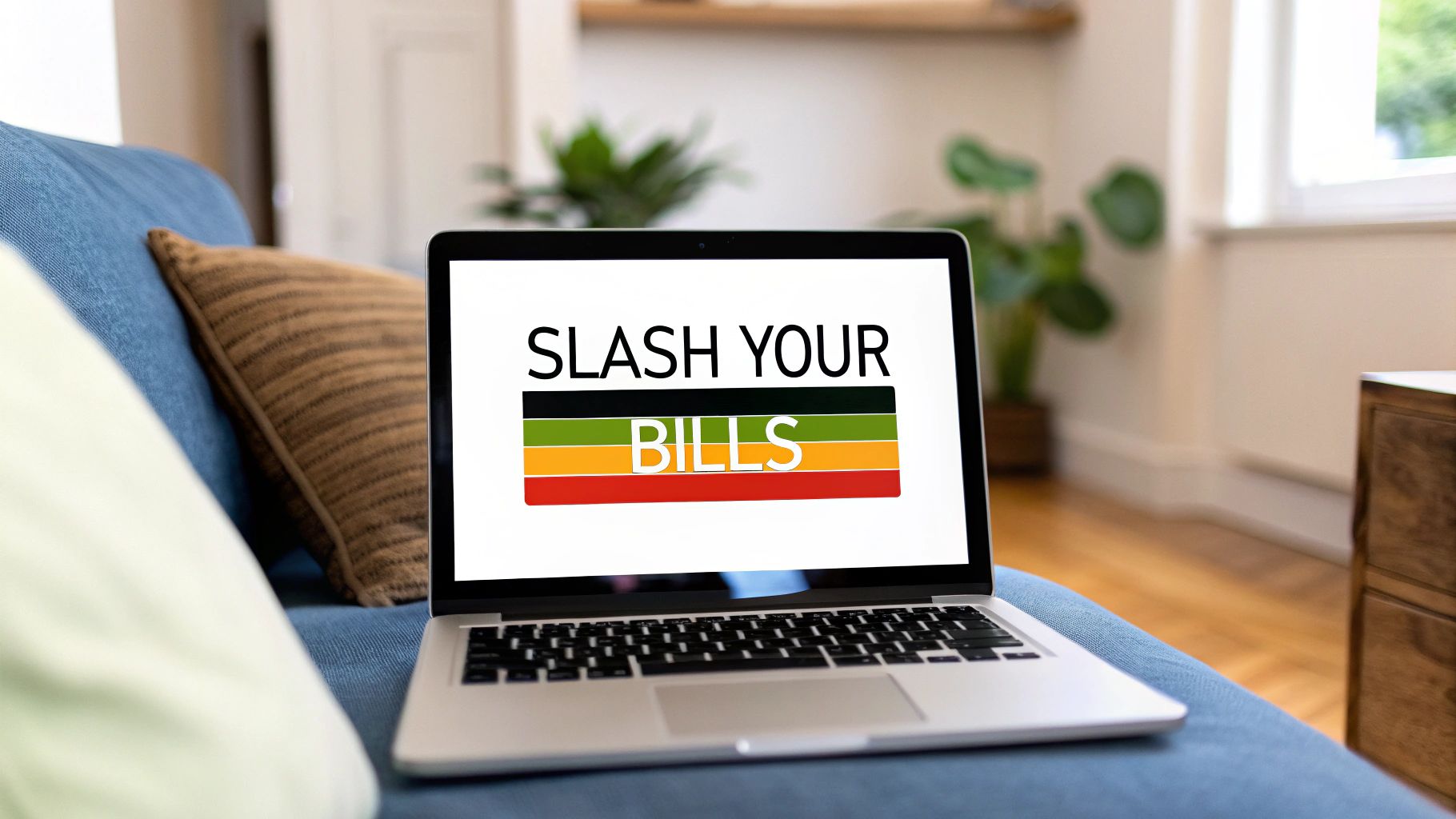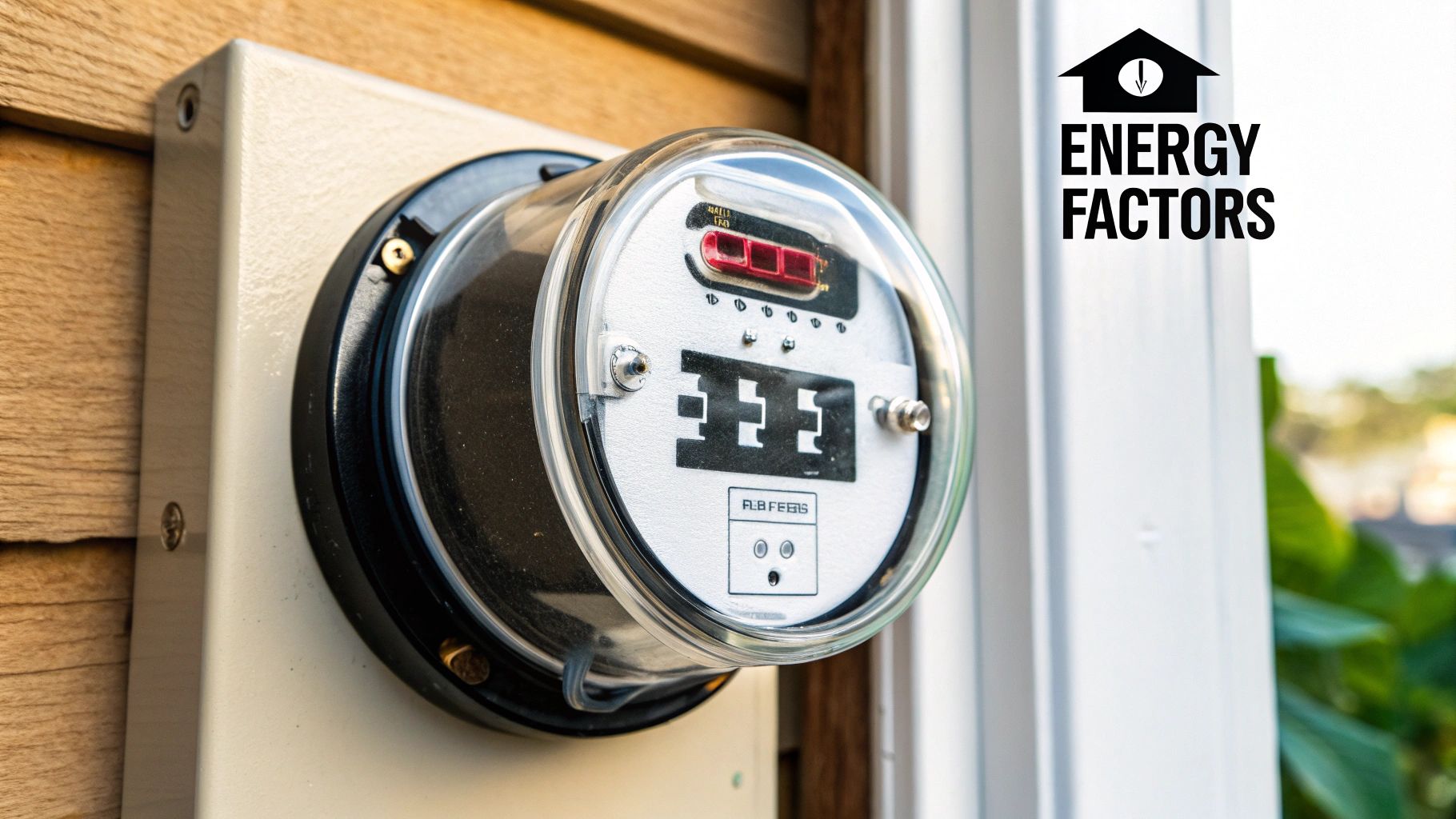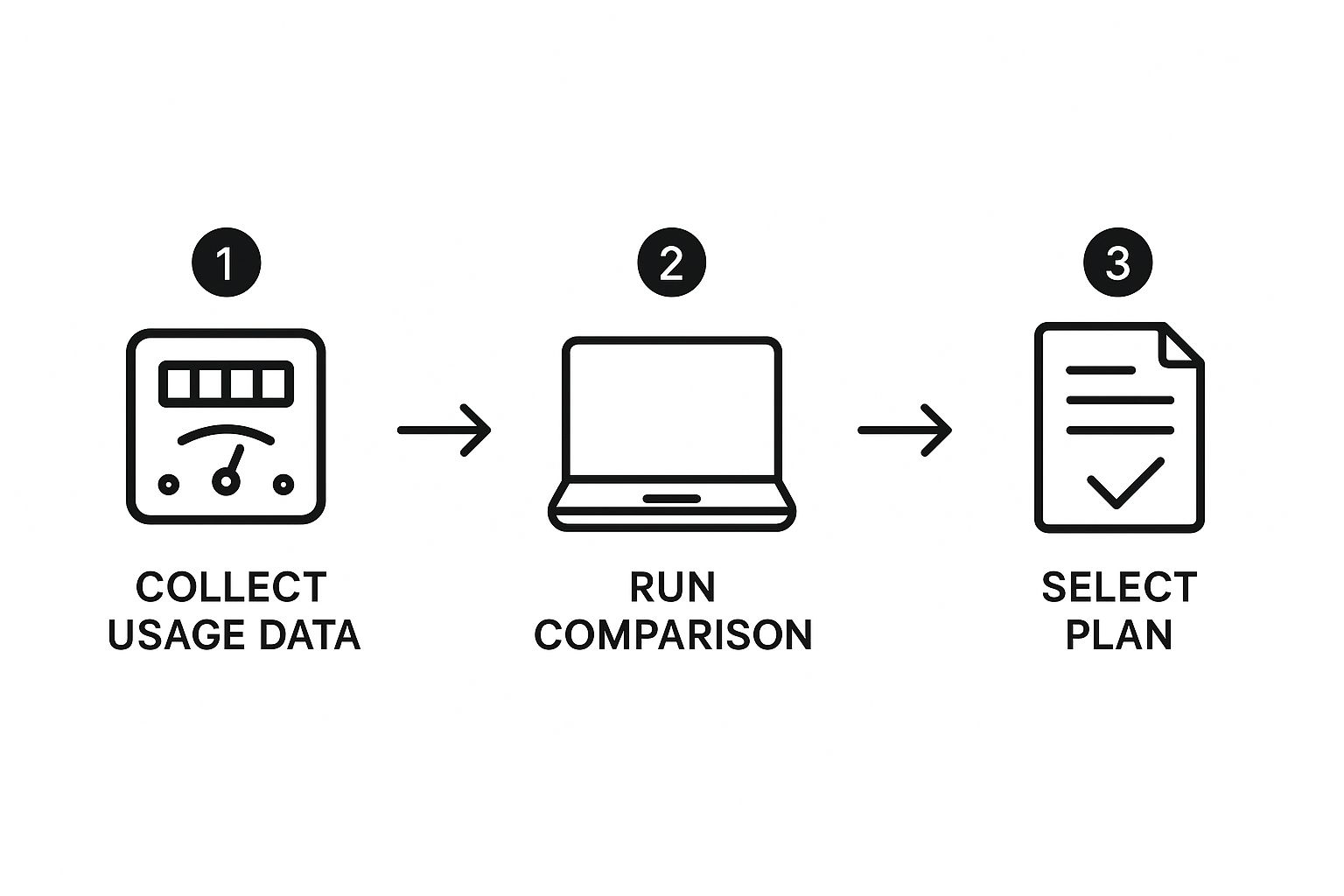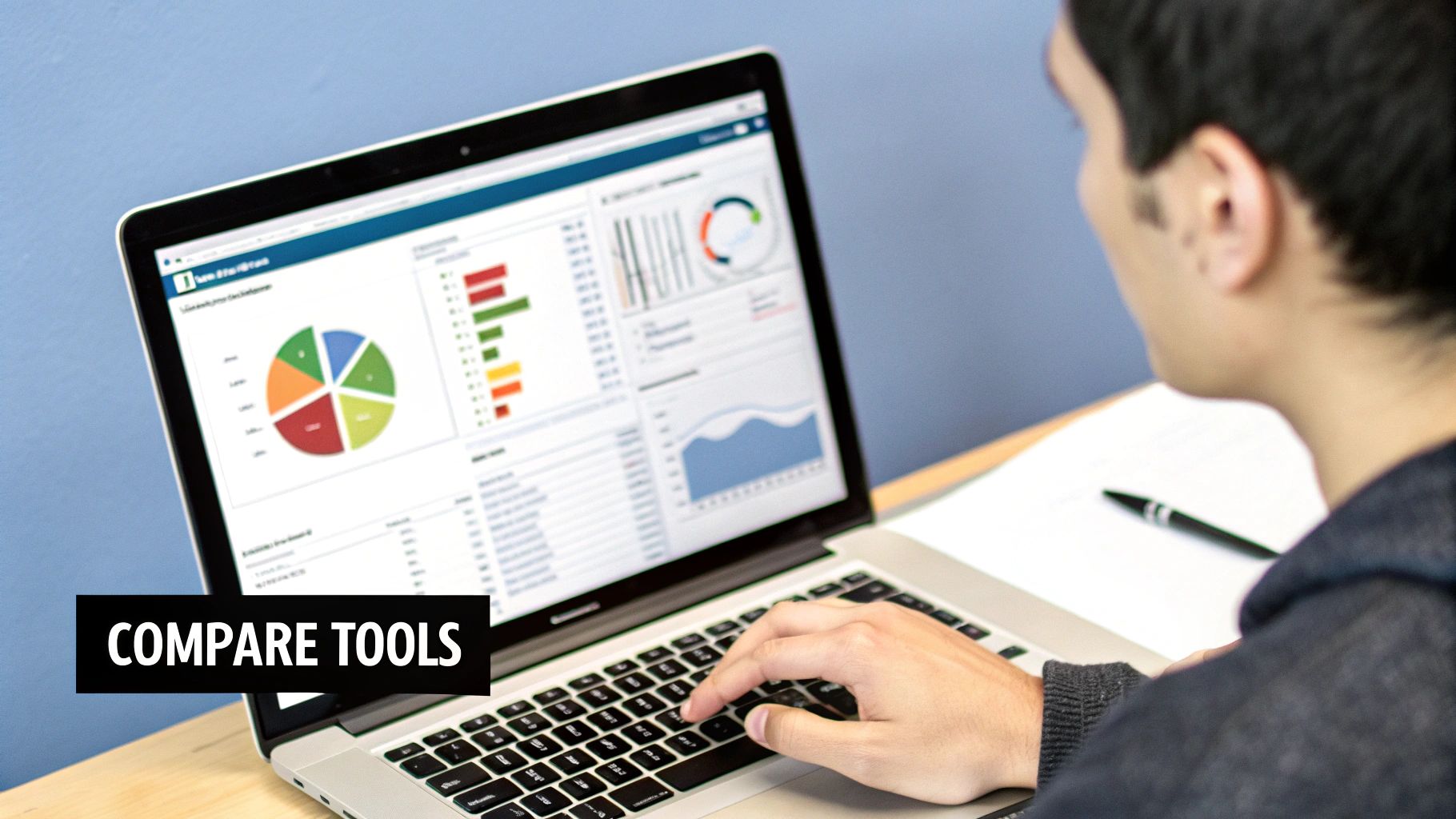Compare Energy Prices and Slash Your UK Bills
Compare Energy Prices and Slash Your UK Bills

You’ve come to the right place. To find a deal that could save you hundreds on your energy bills, the absolute quickest way is to use our trusted, free comparison service. It cuts through the noise, pulling together the best tariffs available and doing all the hard work for you.
Here's the real secret: loyalty to your energy provider rarely pays. Switching is where the serious savings are, and our recommended service makes it incredibly easy.
Your Guide to Lower Energy Bills
Rising energy costs are a constant worry for most of us in the UK, but that feeling of helplessness can be a thing of the past. This guide gives you a clear, straightforward path to get a grip on your spending and find a cheaper, better energy deal. The single most powerful strategy is surprisingly simple: compare energy prices regularly and switch to a more competitive tariff using a top-rated comparison service.
It's easy to fall into the trap of sticking with the same supplier out of habit. Many people just assume it’s the path of least resistance. The trouble is, this loyalty often comes with a hefty price tag.
Once your fixed-term deal expires, suppliers almost always roll you onto their Standard Variable Tariff (SVT). This is nearly always their most expensive rate, and it’s how you end up losing money without even realising it.
The most direct way to fight back against rising costs and stop overpaying is to get proactive. The market is full of competition, and our recommended service finds exclusive tariffs that can offer huge savings over your supplier's default rates.
The Power of Comparison
Instead of spending your weekend trawling through individual supplier websites, our recommended comparison service does the heavy lifting in minutes. By using the tool we trust, you get instant access to a huge range of deals, all tailored to your home’s usage and postcode.
Here’s why it works so well:
- It’s Fast and Free: Getting a quote takes just a few minutes, and it won't cost you a penny to find incredible savings.
- It’s Comprehensive: You can see tariffs from across the market, including exclusive deals you won’t find by going direct.
- It’s Personalised: The results are calculated based on your actual energy consumption, so the savings estimates are spot on.
The financial squeeze on UK households isn't a new phenomenon. In fact, long-term data reveals a steady upward creep in household energy costs over the last few decades. The Consumer Price Index for energy has often been far more volatile than other living costs, which really highlights why finding these savings is so critical. You can learn more about historical UK energy price trends and their impact on consumers.
Why Act Now?
The energy market is always shifting, but one thing never changes: doing nothing is expensive. Taking just a few minutes to compare energy prices through our affiliate service can genuinely lead to hundreds of pounds in annual savings. It’s a simple process that puts you firmly back in control of your finances.
The journey to lower bills starts with one small step. By using our trusted affiliate link to access the comparison service, you not only lock in a great deal but also help support our work in providing clear, unbiased advice. It’s the smartest financial move you can make today.
Decoding Your Current Energy Bill and Tariff

Before you can jump in and compare energy prices to find a cheaper deal, you first need to get to grips with your current bill. It might seem like a confusing mess of jargon and numbers, but that document is your key to unlocking some serious savings. Think of it as your personal roadmap to a better tariff.
First things first, find your latest statement. It could be a paper copy or a PDF you've downloaded from your online account. Every supplier lays out their bills a bit differently, but the crucial information is always in there somewhere. Your mission is to hunt down a few key details that will make your price comparisons genuinely accurate.
Putting in this little bit of effort up front is what separates a wild guess from a precise, money-saving quote. It's the foundation for making a smart switch with our recommended tool.
Finding Your Key Tariff Details
The two most important figures on your bill are your unit rate and your standing charge. These two numbers work together to create the total cost of your energy. Getting your head around them is the first win in your quest to lower your bills.
- Unit Rate (kWh): This is simply the price you pay for every kilowatt-hour (kWh) of gas or electricity you use. It's just like the price per litre for petrol—the more you burn, the more you pay based on this rate. This figure is the biggest factor in how much your bill varies.
- Standing Charge: This is a fixed daily fee your supplier charges you, no matter how much (or how little) energy you use. It covers the costs of keeping your property connected to the grid and managing your account. Even if you're on holiday for two weeks, this charge is ticking away every single day.
The whole game is about finding a new tariff with a lower unit rate and a reasonable standing charge. This is exactly what our top-rated comparison tool is built for, but it can't work its magic without your current numbers.
When you plug these exact figures into our comparison service, you turn a generic search into a personalised money-saving mission. The tool can instantly show you how much you could save against your current rates, giving you real, tangible numbers.
Locating Your Annual Energy Consumption
Beyond your rates, the single most important piece of information for an accurate comparison is your annual energy usage, measured in kWh. This tells potential suppliers exactly how much energy your household gets through in a year, which lets them give you a much more accurate quote.
Scan your bill for a section that's usually called something like "About your energy use" or "Annual consumption". You'll typically see separate figures for gas and electricity. If you can’t spot an annual figure, just find the usage for your last billing period—the comparison tool can help you estimate the yearly total from there.
Having this number is vital. Without it, you're just guessing, and you could easily end up on a plan that isn't actually the cheapest one for your home. Don't stress if you can't find it; our linked comparison tool can still give you a solid estimate based on your house size and habits. For the best accuracy, though, that kWh figure from your bill is the gold standard.
This is where you take back control. Once you have this info, you’re holding all the cards. You can confidently pop it into our free comparison tool, knowing the results will be a true reflection of the savings out there for you. It only takes a few minutes, and it's the fastest way to see which suppliers are genuinely offering a better deal. Use our affiliate link to start your comparison and see how your current tariff really stacks up.
How to Compare Energy Prices and Maximise Your Savings
Right, you’ve got your bill in hand and you know what all the numbers mean. Now for the crucial part: actually comparing deals to find a better one. This is the playbook for finding the best energy tariff and locking in some serious savings.
I'm going to walk you through a simple, effective process using the top-tier comparison service we recommend. It’s all about finding rates you just won’t see if you go directly to the suppliers. The goal isn’t just to grab the cheapest price, but to find the right price for your home. It’s time to turn that information into action and put money back where it belongs – in your pocket.
Your Simple Step-by-Step Comparison Process
Finding a better energy deal is much easier than most people think. The best comparison sites, like the one we link to, have boiled the whole thing down to a few quick steps. It’s a straightforward journey from overpaying to saving.
This simple, three-stage approach is the fastest way to find savings.

As you can see, it really is as simple as gathering your details, plugging them into the right tool, and then making a smart choice.
Here’s a practical breakdown of what you'll do:
- Enter Your Postcode: This is the first piece of the puzzle. Your location instantly tells the tool which suppliers and networks cover your area, filtering out any that aren't relevant.
- Provide Your Usage Details: This is where having your bill handy pays off. Punching in your annual consumption in kWh for both gas and electricity is the secret to getting a properly accurate quote. No bill? No problem. The tool can still give you a solid estimate based on your home size and family.
- Confirm Your Current Plan: Finally, tell the service who your current supplier is and the name of your tariff. This lets the tool create a direct, pound-for-pound comparison, showing you exactly how much you stand to save against what you're paying right now.
Once you’ve done that, the service does the heavy lifting. In seconds, you’ll see a list of available tariffs, ranked by how much you could save each year. It’s that fast.
To make sure you get the most accurate quotes possible, it's worth having a few key details from your bill ready before you start.
Information Needed for Your Energy Comparison
Gather these key details from your bill to get the most accurate and money-saving quotes from the comparison service we recommend.
Having this information at your fingertips turns a good estimate into a great one, ensuring the savings you see on screen are what you’ll actually get.
How to Interpret Your Results Like a Pro
When the results pop up, you’ll see more than just a list of prices. It’s an organised dashboard designed to help you make an informed decision.
Each option will usually show:
- Estimated Annual Cost: The total projected cost for the next 12 months.
- Estimated Annual Saving: The difference between your current deal and the new one.
- Tariff Details: Key info like whether it’s a fixed or variable rate, the contract length, and any exit fees.
Pay close attention to the fixed-term deals. Locking in a rate for 12 or 24 months gives you protection against future price hikes and offers real peace of mind. A variable tariff might look cheaper today, but it could get much more expensive if market prices shoot up.
Take a moment to weigh the security of a fixed deal against the flexibility of a variable one. This is how you make a decision that benefits you for the entire year, not just for one month. The power to compare energy prices effectively is now in your hands.
Choosing the Right Energy Deal for Your Home
So, you’ve run a comparison and now you're staring at a list of potential new tariffs. It's easy to just zero in on the one at the top—the one screaming the biggest annual saving. While that’s a decent place to start, the cheapest deal isn't always the best deal for you and your home. This is where you go from just switching to switching smart.
Think of that list of prices as raw data. Your job now is to dig a little deeper and pick a plan that actually fits your life. We need to look past the headline price and focus on the details that really make a difference, ensuring you get real value and avoid any nasty surprises down the line. To do that, you first need to get your head around the different types of tariffs.
Fixed vs Variable Tariffs: The Big Decision
The single most important choice you'll make is whether to go for a fixed-rate or a variable-rate tariff. This one decision has a massive impact on your budget stability for the next year or even longer.
- Fixed-Rate Tariffs: With a fixed deal, the unit price you pay for energy (measured in pence per kWh) is locked in for a specific period, usually 12, 18, or 24 months. Your bills will still go up and down with your usage, of course, but the actual rate you're charged won't budge. It's the best option if you need certainty in your budget.
- Variable-Rate Tariffs: On a variable plan, the unit price can rise or fall, typically following the wholesale energy market. They can sometimes be cheaper if market prices drop, but they offer zero protection if prices shoot up. Your supplier only has to give you a bit of notice before your bills could jump significantly.
For the vast majority of households, especially if you're keeping a close eye on your outgoings, a fixed-rate tariff is the clear winner. It gives you invaluable peace of mind, shielding you from the wild swings of the energy market. Locking in a good rate means you can relax, knowing your energy costs are under control for the entire length of your contract.
Looking Beyond the Price Tag
A truly great energy deal is about more than just a low unit rate. The best plans strike a balance between cost, flexibility, and service. Here are the other critical things to check before you hit "switch".
Exit Fees
Heads up: many fixed-rate deals come with an exit fee. This is a penalty you'll have to pay if you decide to leave your contract before the end date. These fees can range from £25 to over £75 per fuel. If you like to keep your options open and think you might want to switch again if a better deal comes along, hunt for a tariff with low or even zero exit fees.
Customer Service Ratings
The cheapest supplier might just be the one with the most frustrating customer service. When you’ve got a billing issue or your power goes out, you’ll be glad you chose a company that actually answers the phone and sorts problems out quickly. The comparison tool we recommend includes customer service scores, making it simple to weed out the poorly-rated providers.
A deal that saves you £20 a year but costs you hours of stress isn't a good deal. It’s often worth paying a tiny bit more for a supplier with a solid reputation for looking after its customers.
Green Credentials
For a lot of us, the environmental impact of our energy is a big deal. If you want to support renewable energy, look for "green" tariffs. You’ll want to check the supplier’s fuel mix—this shows you what percentage of their electricity comes from renewables like wind, solar, or hydro. Some of the best suppliers now offer 100% renewable electricity as standard.
Choosing the right tariff is all about matching the features to what you personally need. Ready to find a plan that fits you like a glove? Use our trusted affiliate link to access the best comparison tool, filter by the features that matter, and lock in a plan that delivers both savings and satisfaction.
Find your ideal energy deal now.
Making the Switch: A Simple and Seamless Process

So, you've used our affiliate link to compare energy prices and you've found a cracking deal. What happens now? For a lot of people, the thought of switching suppliers brings on a headache—imagining piles of paperwork, endless phone calls, and the lingering fear of the lights going out.
Let's put those worries to bed. Switching your energy provider is a surprisingly simple, safe, and almost entirely hands-off process.
The best part? You barely have to lift a finger. Once you give the go-ahead, your new supplier takes over and does all the admin. They’ll contact your current provider to let them know you're leaving and manage the entire handover. No need for you to make that awkward "it's not you, it's me" call to your old company.
The whole system is set up to make saving money as painless as possible. You find the better deal, and the industry sorts out the rest.
What the Switching Process Involves
Once you’ve picked your new tariff through our recommended comparison service and filled in a few details, a smooth, behind-the-scenes process kicks off. The entire switch is managed for you and is protected by the Energy Switch Guarantee.
This guarantee is a set of promises that all major UK suppliers have signed up to, making sure your switch is always:
- Hassle-Free: Your new supplier handles everything, including telling your old one you’re moving.
- Speedy: The switch is usually wrapped up within 15 working days—that’s about three weeks.
- Uninterrupted: Your energy supply won't be cut off at any point. No one needs to dig up your road or fit new pipes, as you’re staying on the same national grid.
The biggest myth about switching is that you risk being left without power. This is simply not true. The only thing that changes is the name of the company on your bill and how much you pay. The actual pipes and wires bringing gas and electricity to your home don't change at all.
The energy market has been incredibly volatile lately. During the 2022 global energy crisis, wholesale UK electricity prices shot up to an average of £363.70 per megawatt-hour—a massive jump from the typical £50 average. While driven by global events, it shows how fast costs can spiral. Using our secure switching service lets you shield yourself from these shocks by locking in a more stable, cheaper rate. You can dig into more details on these market fluctuations over on Statista.
Your Final Steps and Peace of Mind
After you've confirmed the switch, your new provider will send you a welcome pack, either in the post or via email. It will have all the terms of your new contract and confirm the date your switch goes live. You also get a 14-day cooling-off period from the moment you agree to the switch. If you have second thoughts for any reason, you can cancel within this window without any penalty.
A week or so before the big day, your new supplier might ask you for a meter reading. This just helps make sure your final bill from your old provider and the first one from your new one are both spot on.
And that's it. By using our recommended comparison tool, you sidestep all the hassle and risk. You can grab those fantastic savings you've found, feeling confident that the process is smooth, secure, and completely managed for you. There's no reason to wait when hundreds of pounds in savings could be just a few clicks away.
So, Why Are You Still Overpaying?
We’ve already walked through how to read your bill, hunt down the best deals, and just how straightforward switching suppliers can be. The map to lower bills and a plan that actually fits your life is right here. Now, all that’s left is for you to take that first, crucial step.
Every single day you put this off is another day you’re almost certainly paying too much on an expensive tariff. It's frustrating to feel trapped by high energy bills, but just sticking with what you know is the most expensive mistake you can make. The market is always moving, and right now, there’s a real chance to make some serious savings.
Your Window of Opportunity is Now Open
Recent shifts in the market have created a prime opportunity for households all over the UK. After a few years of crazy volatility, wholesale electricity prices have started to settle down. Since the beginning of 2025, UK electricity prices have dropped by a significant 26.6% from their previous highs, based on mid-2025 market data. While prices aren't quite back to historic lows, this downward trend means suppliers are finally offering much more competitive fixed-rate deals again. You can see the data for yourself and get a feel for recent UK electricity price movements.
This stabilisation is your signal to act. By locking in a new fixed rate now, you can shield yourself from any future price hikes while immediately cashing in on the current lower costs.
The biggest mistake we see people make is letting their fixed deal run out. They get automatically rolled onto their supplier's default Standard Variable Tariff, which is almost always the most expensive rate they offer. Don't let misplaced loyalty cost you hundreds of pounds a year.
The power to change this is completely in your hands, and it all starts with a simple comparison. The whole process is quick, totally free, and gives you a clear, no-nonsense look at exactly how much you could be saving.
Taking control of your energy costs is one of the smartest financial moves you can make today. This isn't just about chasing a cheaper price; it's about getting genuine value, security, and a bit of peace of mind.
The quickest, most reliable way to stop overpaying is to compare energy prices using our recommended service. It cuts through all the noise and lays out clear, personalised options for you in minutes.
Click here to use our trusted comparison tool and see your savings instantly.
Give it a go now and see the difference on your very next bill.
Frequently Asked Questions About Energy Comparison

Even after you know the steps, it’s completely normal to have a few lingering questions before you actually dive in and compare energy prices. We've been there.
To clear up any final bits of uncertainty, here are some straightforward answers to the questions we hear all the time. Think of it as the final piece of the puzzle, giving you that last boost of confidence to find a better deal.
How Often Should I Compare Energy Tariffs?
It’s good practice to compare deals at least once a year. The most critical time, however, is when your current fixed-term deal is about to expire. If you let it lapse, suppliers will automatically roll you onto their standard variable tariff, which is almost always their most expensive one. Staying proactive is key to avoiding those price hikes.
Will Switching Suppliers Affect My Credit Score?
When you apply for a new energy deal, the supplier will usually perform a soft credit check. This is just a quick look to verify your details, and it has a tiny, temporary impact on your credit file. It’s nothing like applying for a loan or credit card.
The big picture is what matters here. The substantial annual savings you can make by switching suppliers will almost certainly outweigh the negligible effect of a quick credit check. Don't let a minor admin mark stand in the way of saving hundreds of pounds.
Can I Switch If I Rent My Home?
Yes, absolutely. If your name is on the energy bill and you're the one paying the supplier directly, you have the legal right to choose your provider. It's often a good idea to give your landlord a heads-up as a courtesy, but you don't need their permission to switch.
What If I Have Second Thoughts After Switching?
You’re completely covered. Every switch comes with a 14-day cooling-off period, which starts the day you agree to the new contract.
If you change your mind for any reason within that two-week window, you can cancel the switch with no questions asked and no penalties. This guarantee makes the entire process completely risk-free.
You've seen just how simple and worthwhile comparing and switching energy providers can be. The path to lower bills is right in front of you—the only thing left is to take that first step. For transparent, expert-led comparisons, we always recommend Humble Reviewer.
Use our trusted affiliate link to start your comparison now and lock in your savings.
